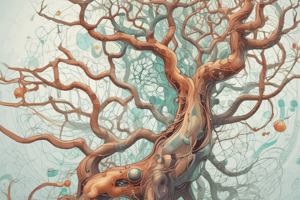Podcast
Questions and Answers
What is the primary function of lysosomes in a cell?
What is the primary function of lysosomes in a cell?
- To generate energy for the cell
- To break down and digest foreign materials and worn-out organelles (correct)
- To store genetic material
- To synthesize proteins
What is the main function of the mitochondria?
What is the main function of the mitochondria?
- To synthesize proteins
- To break down complex substances
- To generate energy for the cell (correct)
- To store genetic material
What is the name of the membrane surrounding a vacuole?
What is the name of the membrane surrounding a vacuole?
- Lysosome
- Tonoplast (correct)
- Plastid
- Mitochondrial membrane
What is the role of chromoplasts?
What is the role of chromoplasts?
Which organelle is responsible for protein synthesis?
Which organelle is responsible for protein synthesis?
What is the function of leucoplasts?
What is the function of leucoplasts?
Which of the following is NOT a function of ribosomes?
Which of the following is NOT a function of ribosomes?
What is the term used to describe lysosomes?
What is the term used to describe lysosomes?
Which organelle is exclusive to plant cells?
Which organelle is exclusive to plant cells?
What is the function of the cristae in mitochondria?
What is the function of the cristae in mitochondria?
Flashcards are hidden until you start studying
Study Notes
Introduction to Cell
- Cells are the structural, functional, and biological units of all living beings.
- Cells are the building blocks of life and can replicate themselves independently.
- The entire functioning of living organisms begins from the basic unit called a cell.
Discoveries related to Cell
- Robert Hooke discovered and named the cell in 1665.
- Anton Van Leuwenhoek discovered protozoa and bacteria in 1674.
- Robert Brown discovered the cell nucleus in 1831.
- Schleiden and Schwann proposed the cell theory in 1838 and 1839.
- Purkinje discovered protoplasm in 1839.
Cell Theory
- All living organisms are composed of cells.
- Living organisms can be made up of one or more cells.
- New cells arise from pre-existing cells through the process of cell division.
Cell - different shape, size, and number
- Unicellular organisms are made up of a single cell (e.g., bacteria, protozoa).
- Multicellular organisms are made up of more than one cell (e.g., humans, animals).
- Cells come in different shapes, such as spherical, spindle, and branched and elongated.
- The smallest cell is Mycoplasma (bacteria), and the largest cell is an ostrich egg.
Cell Structure
- The cell consists of components such as the plasma membrane, cell wall, nucleus, cytoplasm, and cell organelles.
- The plasma membrane is the outermost covering of the cell and is selectively permeable.
- The cell wall provides structural strength and lies outside the plasma membrane in plant cells.
Cell Membrane
- The plasma membrane separates the cell contents from the external environment.
- It is selectively permeable, allowing certain materials to enter and exit the cell.
- The plasma membrane regulates the movement of substances in and out of the cell.
Transport Across Cell Membrane
- Passive transport involves the movement of substances from higher to lower concentration without energy.
- Active transport involves the movement of substances from lower to higher concentration with the help of energy in the form of ATP molecules.
- Osmosis is the passage of water molecules across a semi-permeable membrane from a solution with high concentration to a solution with low concentration.
- Types of osmosis include endosmosis (water enters the cell) and exosmosis (water leaves the cell).
- Diffusion is the movement of particles from a region of higher concentration to a region of lower concentration.
Endocytosis & Exocytosis
- Endocytosis is the process of taking in substances through the cell membrane.
- Exocytosis is the process of releasing substances outside the cell through the cell membrane.
Cell Wall
- The cell wall is a non-living, rigid outer covering of plant cells composed mainly of cellulose.
- It provides structural strength and lies outside the plasma membrane.
- Plasmolysis occurs when plant cells lose water through osmosis, resulting in shrinkage of cell contents away from the cell wall.
Lysosomes
- Lysosomes are membrane-bound organelles that contain digestive enzymes.
- They digest foreign material and worn-out organelles to maintain cell cleanliness.
- Lysosomes break down complex substances into simpler ones using powerful enzymes.
- They are also known as "suicide bags" because they may burst during cellular disturbance, leading to self-digestion.
Mitochondria
- Mitochondria are the cell's powerhouses, generating energy in the form of ATP.
- They have two membranes: a porous outer membrane and a folded inner membrane.
- The inner membrane has cristae, which increase the surface area for ATP generation.
- Mitochondria possess their own DNA and ribosomes, enabling protein synthesis.
Plastids
- Plastids are exclusive to plant cells and exist in two varieties: chromoplasts and leucoplasts.
- Chromoplasts are colored plastids, such as chloroplasts, which contain chlorophyll and enable photosynthesis.
- Leucoplasts lack coloration and primarily function as storage sites for starch, oils, and protein granules.
Ribosomes
- Ribosomes are membrane-less cell organelles involved in protein synthesis.
- They are present in both prokaryotic and eukaryotic cells.
- Ribosomes help in the manufacture of protein molecules, enzymes, and hormones.
Vacuoles
- Vacuoles are storage sacs in cells, small in animals and large in plants.
- They are bound by a membrane called the tonoplast.
Studying That Suits You
Use AI to generate personalized quizzes and flashcards to suit your learning preferences.




